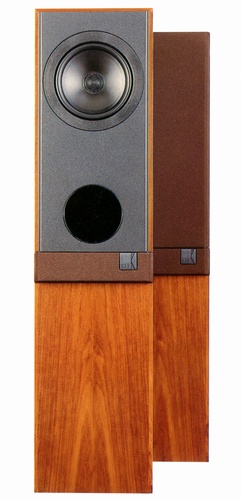
KEF Model103/4S
¥ 175,000 (1 unit, around 1991)
Commentary
This is a tall boy type speaker system with a large scale expressive power in spite of its simple structure.
A TCC (Twin Coupled Cavity) system using two 20 cm cone type woofers is adopted to enhance the low-frequency reproduction capability.
This system employs a structure in which two woofers are mounted horizontally and vertically inside the enclosure. By twin-driving the woofers, natural deep bass sound is emitted instantaneously from a low-frequency port called an air diaphragm.
This structure looks similar to the bass reflex method, but the operation principle is different. In the bass reflex method, the resonance effect is used to increase the quantitative bass sensation, so it tends to be played back as sound after being delayed by one wavelength, or the bass expression tends to be wrapped around regardless of the musical tone. In the TCC system, the top and bottom horizontal woofers each have a sealed cavity, and an air diaphragm is arranged in an intermediate space between the woofers, so that the air layer acts as an effective load against the movement of the woofer and achieves high efficiency.
In addition, the magnets of the two woofers are connected to each other by a special rod. This not only serves as a four scan cell to prevent delayed resonance, which causes congestion, but also converts the force given by the two upper and lower magnetic circuits into acoustic energy.
This TCC system prevents the cancellation phenomenon that occurs when the phase of the unit and the duct are opposite to each other below the resonance frequency that occurs with the bass reflex system.
A coaxial unit UNI-Q driver composed of a 16 cm cone type unit and a 2.5 cm soft dome type tweeter is installed in the middle and high area.
The UNI-Q Driver is different from the coaxial unit which is unified only on the plane. In order to achieve a single sound in the depth direction, the structure in which the acoustic centers of two units, a tweeter and a driver, are completely overlapped is adopted.
In order to realize this UNI-Q structure, a new magnetic material, neodymium iron boron, which has 10 times the energy of ferrite, is used for the magnetic circuit of the tweeter, and the magnetic circuit of the miniaturized tweeter is superimposed inside the voice coil of the low frequency unit.
It uses a CLM mechanism to convert irregular and complex speaker impedance into an infinitely flat resistance value over the audible frequency band.
High compression MDF with sufficient mass and moderate internal losses is used in the baffle area where the unit is mounted, and the exterior of the enclosure has a walnut finish with a symmetrically grained wood veneer.
The characteristics of the left-right pair unit and the right-left pair network are strictly controlled by a computer, and the sound pressure level is kept within 0.5 dB for both left and right.
It uses a separate type input terminal for bi-amplifier connection.
Removable spike and spike cover can be equipped.
Model Rating
| Method | 3-Way, 3-Speaker, Bass Reflex System, Tall Boy Type |
| Units Used | For low band : 20 cm cone x2 For mid-range and high-range : coaxial type (16 cm cone type, 2.5 cm dome type) |
| Frequency characteristic | 50 Hz ~ 20 kHz ± 2.5 dB (2m on axis) |
| Sound pressure level | 91 dB (1m on the reference axis, 50 Hz to 20 kHz, anechoic room, at 2.83 Vrms pink noise input) |
| Impedance | 4 Ω (± 2.5 dB, 50 Hz to 20 kHz) |
| Crossover frequency | 180 Hz, 2.4 kHz |
| Rated input | 100W |
| Max Input | 200W |
| External dimensions | Width 215x Height 900x Depth 305 mm |
| Weight | 19.1kg |
.jpg)
.jpg)
.jpg)
.jpg)
.jpg)
.jpg)
.jpg)
.jpg)